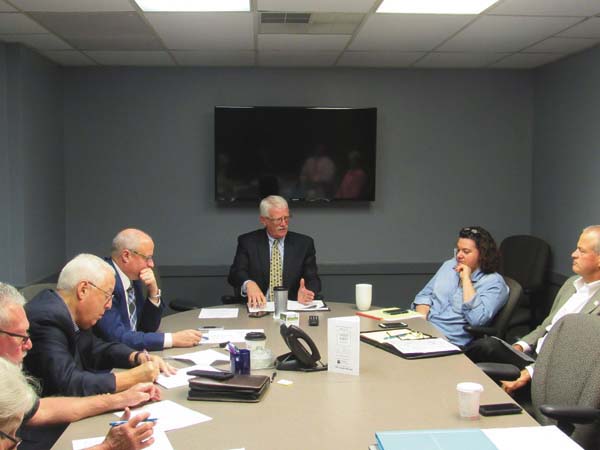GLOVERSVILLE — The Fulton County Center for Regional Growth Board of Directors heard about city initiatives being developed by the Fulton-Montgomery County CEO Roundtable during Friday’s meeting.
CRG Board of Directors Chairman Geoffrey Peck shared with the board that the CEO Roundtable recently identified the city as an area of focus for the group and formed a committee to develop and implement downtown initiatives to aid in grant seeking efforts.
“We had a conversation about the lack of traction and movement in Gloversville’s identified priority projects,” Peck said. “We decided that there needed to be a concentrated focus on a small number of those initiatives to start to move something forward.”


Peck noted that priority projects for the city were identified years earlier when the city applied for Upstate Revitalization Initiative funding through the state’s Regional Economic Development Councils, but he said those projects have yet to be advanced.
“Priority projects were identified five years ago as part of the URI process that have not moved in that period of time, yet continue to be included in the downtown strategy and in the downtown grant application each year,” Peck said.
The city has included proposals for streetscape improvements on South Main and Harrison streets, lawn improvements at Estee Commons near the bronze sculptures, connection of the Rail Trail to downtown, a skate park at the corner of Bleecker and Church streets and a redesign of Castiglione Park on several applications for the state’s now yearly $10 million Downtown Revitalization Initiative award.
The application presented by city officials this year focuses on development of downtown buildings for residential and commercial purposes, as well as the creation of a recreational and commercial corridor. Extension of the Rail Trail and a redesign of Castiglione Park were also included in the application again this year.
No winner for the Mohawk Valley has been announced for 2018 yet.
Peck argued that demonstrating progress on the city’s priority projects will aid current revitalization efforts and improve the chances that the city will be awarded grant funding by the state.
“To show the governor’s office and EP economic development that we’re getting something done in Gloversville, we’re worthy of drawing some grant money,” Peck said.
In this regard, Peck said the CEO Roundtable has identified three short and long range projects to focus on.
The first project is the redevelopment of Burr Street, which abuts South Main Street downtown and was previously identified by the city as one of the poorest and most disinvested areas.
Peck said the roundtable committee is working with Fulton County Planning Director Scott Henze to identify properties for redevelopment and to gather information regarding the tax statuses and owners of the properties for future plans.
“We moved forward quite aggressively in working with the county to identify exactly what those properties are,” Peck said. “We can work on potentially getting some options on those properties in the future.”
The second project will involve improving one of the city’s entryways along East Fulton Street and the fenced in basketball court at the Elk Street Playground, commonly referred to as the “cage,”
Peck said Townsend Leather Senior Vice President Tim Beckett located a not-for-profit organization that has completed beatification projects and put together youth programs in other areas as a potential partner to work with the city to develop a plan.
“They’re willing to work for us almost pro bono, for basic travel costs, if we want to bring them in and put together some action plans for moving that project forward very quickly,” Peck said.
The third project would involve a street beatification campaign that would see volunteers from local businesses and not-for-profits clean and mow individual city streets. After a particular street was clear, the group would put up a small sign for a few days to alert locals to work that had been done.
Peck described the signs as being similar in size and appearance to common political signs that would be used as a way to promote the volunteer effort. The signs would stay up for a brief time until the street team moved onto another area.
“All of a sudden we’d be developing a brand and hopefully take on some traction for more people being interested in being part of that beatification project,” Peck explained.
The board responded positively to the potential projects that are still being developed by the CEO Roundtable, but Peck noted that once implemented the individual projects will have both immediate and long term impacts.
“One that can be enacted immediately and make an impact and be visual,” Peck said, “a short term project that can have some impact and the third one that’s going to be longer in duration and larger in scope, but that could be transformational in downtown in bringing in population, taking an area that’s probably at the top of the heap for blight and reforming that and starting to branch out from there.”



